HA 3011 Advanced Financial Accounting: A Case Study on Enron's Fall
VerifiedAdded on 2023/06/05
|12
|2952
|85
Case Study
AI Summary
This case study delves into the downfall of Enron, examining the accounting practices that led to its collapse. It focuses on the use of mark-to-market accounting, special purpose entities (SPEs), and stock options, highlighting how these mechanisms were manipulated to misrepresent the company's financial health. The report references an article by Paul M. Healy and Krishna G. Palepu, providing a detailed analysis of Enron's fraudulent activities and their impact on investors. Additionally, the study compares International Financial Reporting Standards (IFRS) with US Generally Accepted Accounting Principles (GAAP), using Wesfarmers Ltd and Mackay Golf Club as examples to illustrate the differences in financial statement presentation and valuation methods. The analysis concludes that while both IFRS and US GAAP have their strengths, IFRS offers simpler and more understandable methods for recognizing and measuring assets and liabilities.
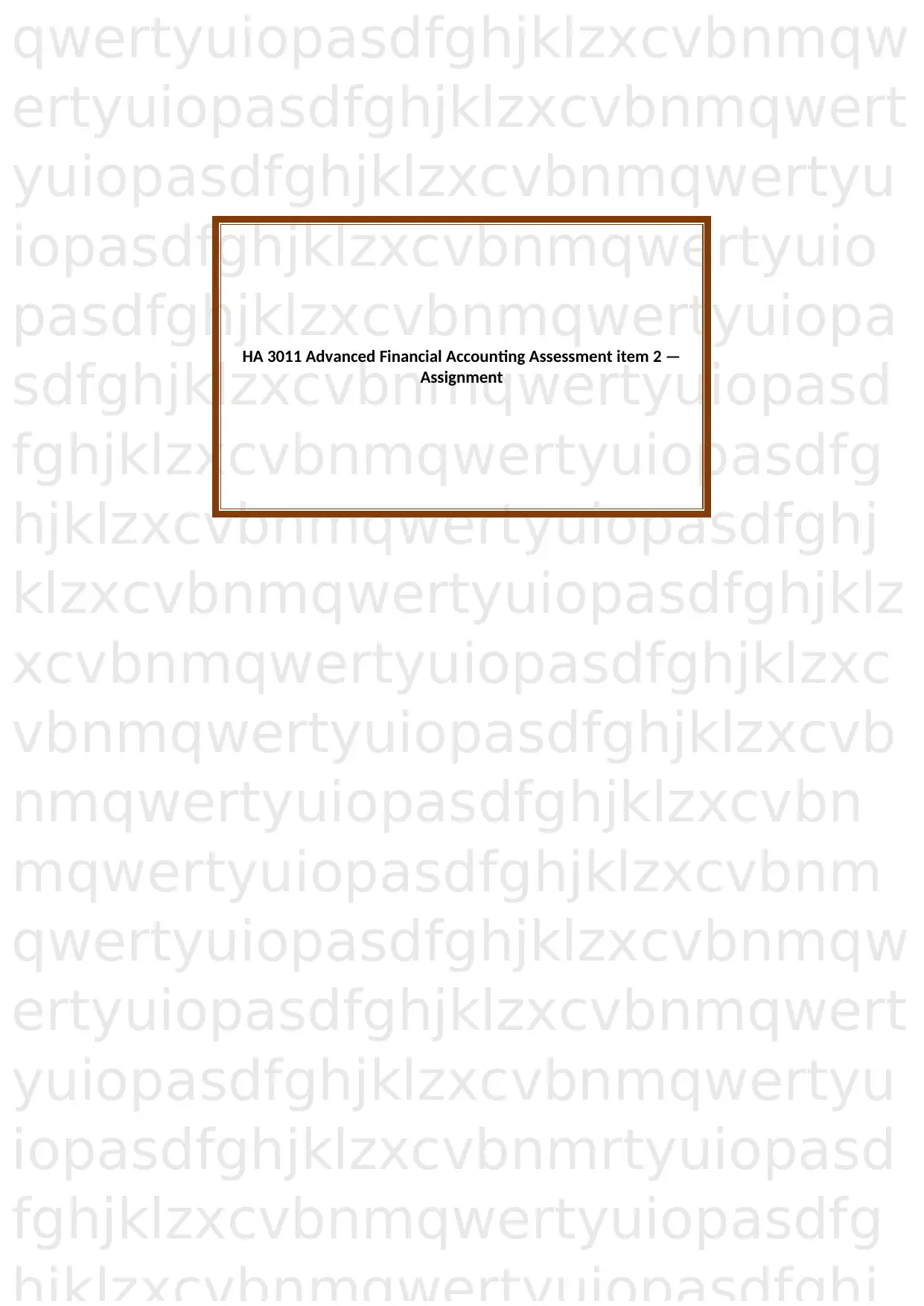
qwertyuiopasdfghjklzxcvbnmqw
ertyuiopasdfghjklzxcvbnmqwert
yuiopasdfghjklzxcvbnmqwertyu
iopasdfghjklzxcvbnmqwertyuio
pasdfghjklzxcvbnmqwertyuiopa
sdfghjklzxcvbnmqwertyuiopasd
fghjklzxcvbnmqwertyuiopasdfg
hjklzxcvbnmqwertyuiopasdfghj
klzxcvbnmqwertyuiopasdfghjklz
xcvbnmqwertyuiopasdfghjklzxc
vbnmqwertyuiopasdfghjklzxcvb
nmqwertyuiopasdfghjklzxcvbn
mqwertyuiopasdfghjklzxcvbnm
qwertyuiopasdfghjklzxcvbnmqw
ertyuiopasdfghjklzxcvbnmqwert
yuiopasdfghjklzxcvbnmqwertyu
iopasdfghjklzxcvbnmrtyuiopasd
fghjklzxcvbnmqwertyuiopasdfg
HA 3011 Advanced Financial Accounting Assessment item 2 —
Assignment
ertyuiopasdfghjklzxcvbnmqwert
yuiopasdfghjklzxcvbnmqwertyu
iopasdfghjklzxcvbnmqwertyuio
pasdfghjklzxcvbnmqwertyuiopa
sdfghjklzxcvbnmqwertyuiopasd
fghjklzxcvbnmqwertyuiopasdfg
hjklzxcvbnmqwertyuiopasdfghj
klzxcvbnmqwertyuiopasdfghjklz
xcvbnmqwertyuiopasdfghjklzxc
vbnmqwertyuiopasdfghjklzxcvb
nmqwertyuiopasdfghjklzxcvbn
mqwertyuiopasdfghjklzxcvbnm
qwertyuiopasdfghjklzxcvbnmqw
ertyuiopasdfghjklzxcvbnmqwert
yuiopasdfghjklzxcvbnmqwertyu
iopasdfghjklzxcvbnmrtyuiopasd
fghjklzxcvbnmqwertyuiopasdfg
HA 3011 Advanced Financial Accounting Assessment item 2 —
Assignment
Paraphrase This Document
Need a fresh take? Get an instant paraphrase of this document with our AI Paraphraser
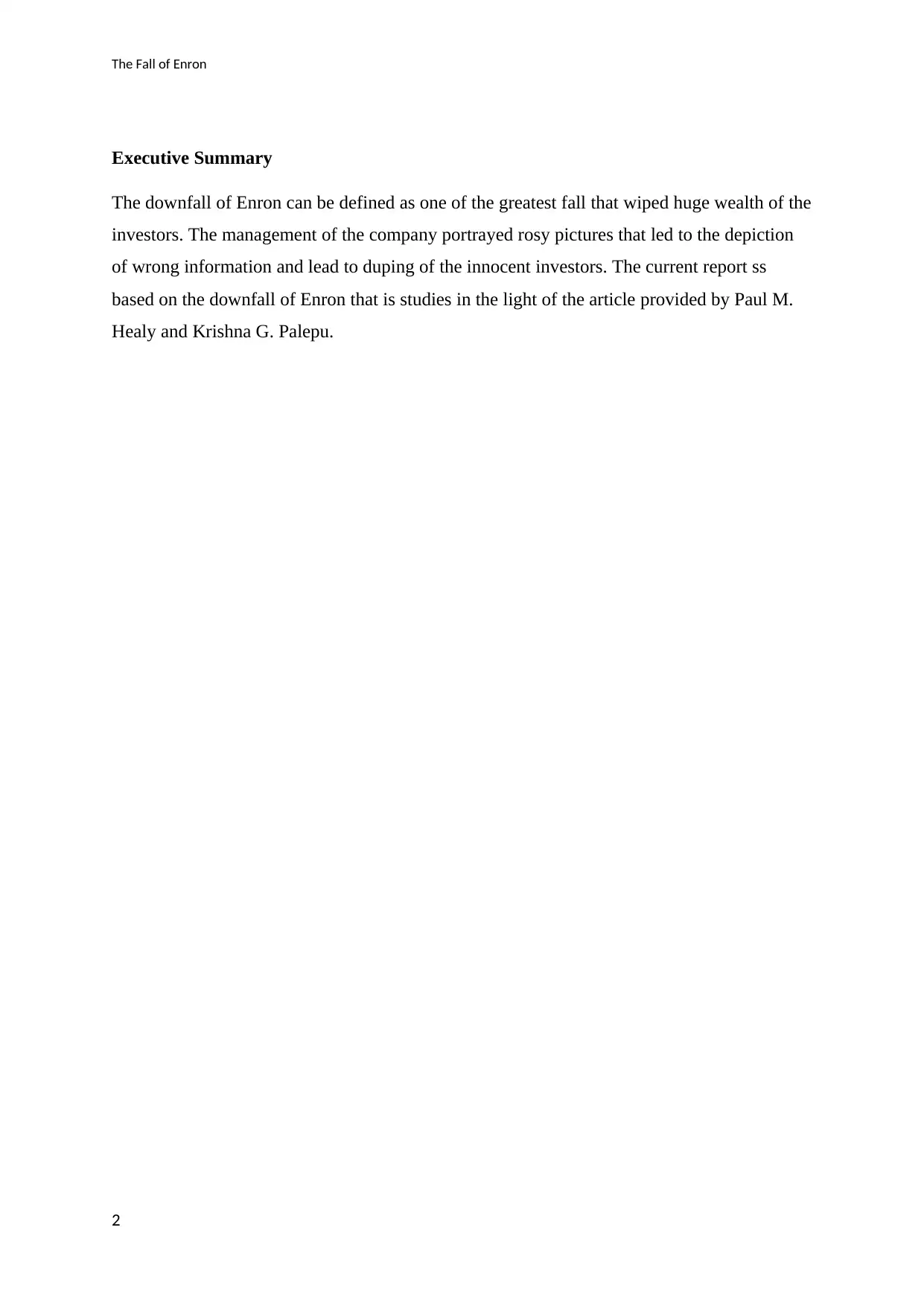
The Fall of Enron
Executive Summary
The downfall of Enron can be defined as one of the greatest fall that wiped huge wealth of the
investors. The management of the company portrayed rosy pictures that led to the depiction
of wrong information and lead to duping of the innocent investors. The current report ss
based on the downfall of Enron that is studies in the light of the article provided by Paul M.
Healy and Krishna G. Palepu.
2
Executive Summary
The downfall of Enron can be defined as one of the greatest fall that wiped huge wealth of the
investors. The management of the company portrayed rosy pictures that led to the depiction
of wrong information and lead to duping of the innocent investors. The current report ss
based on the downfall of Enron that is studies in the light of the article provided by Paul M.
Healy and Krishna G. Palepu.
2
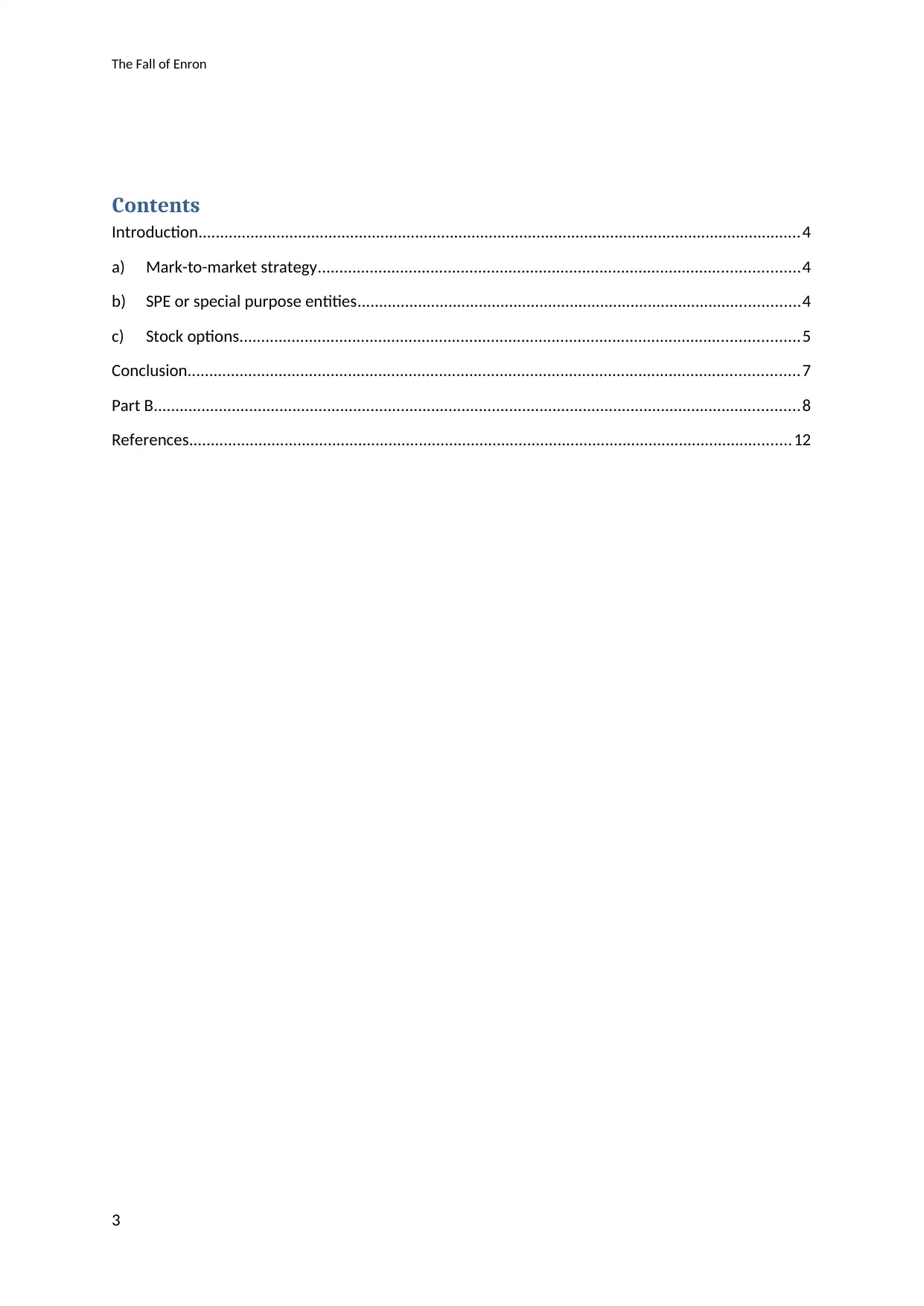
The Fall of Enron
Contents
Introduction...........................................................................................................................................4
a) Mark-to-market strategy...............................................................................................................4
b) SPE or special purpose entities......................................................................................................4
c) Stock options.................................................................................................................................5
Conclusion.............................................................................................................................................7
Part B.....................................................................................................................................................8
References...........................................................................................................................................12
3
Contents
Introduction...........................................................................................................................................4
a) Mark-to-market strategy...............................................................................................................4
b) SPE or special purpose entities......................................................................................................4
c) Stock options.................................................................................................................................5
Conclusion.............................................................................................................................................7
Part B.....................................................................................................................................................8
References...........................................................................................................................................12
3
⊘ This is a preview!⊘
Do you want full access?
Subscribe today to unlock all pages.

Trusted by 1+ million students worldwide
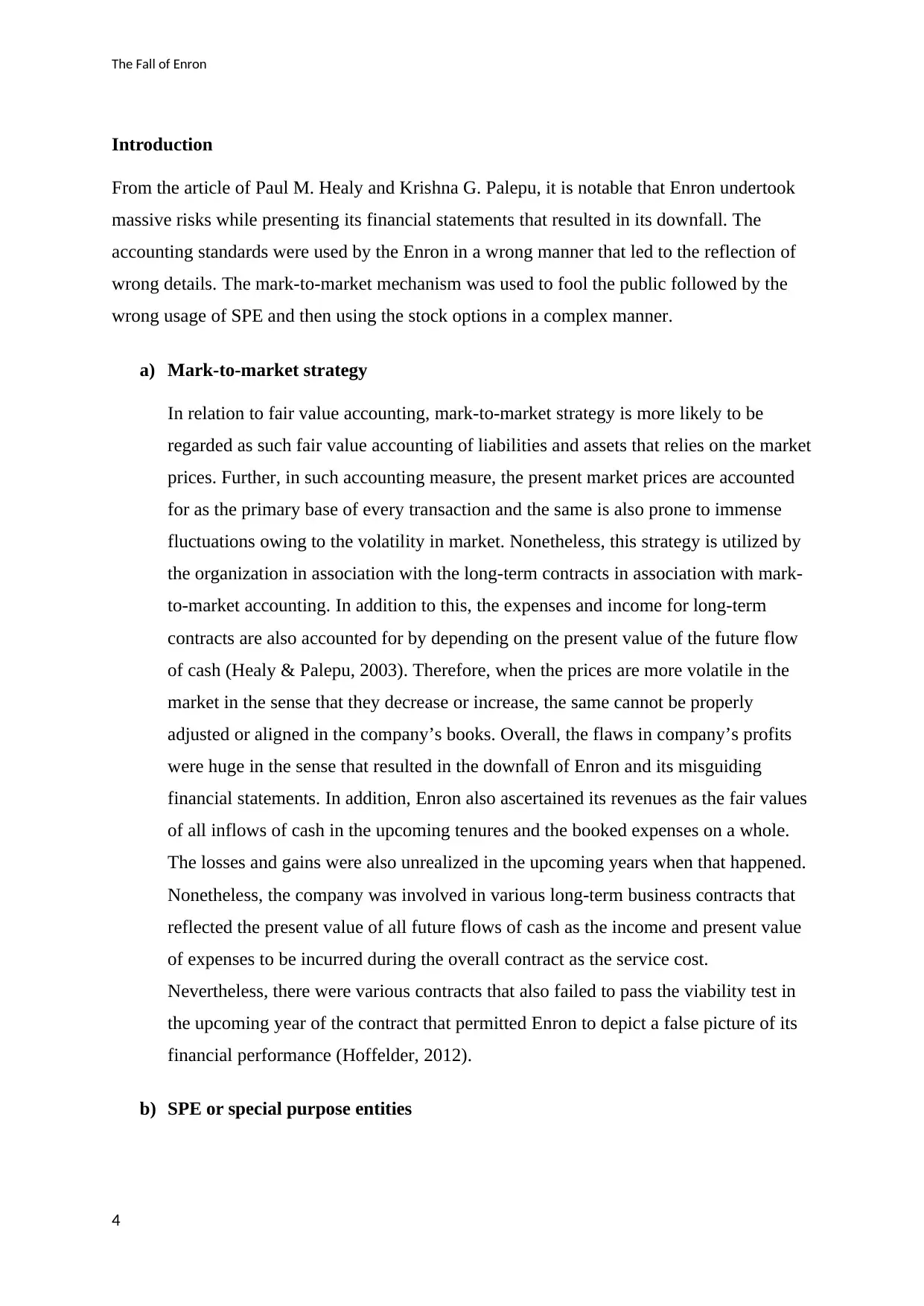
The Fall of Enron
Introduction
From the article of Paul M. Healy and Krishna G. Palepu, it is notable that Enron undertook
massive risks while presenting its financial statements that resulted in its downfall. The
accounting standards were used by the Enron in a wrong manner that led to the reflection of
wrong details. The mark-to-market mechanism was used to fool the public followed by the
wrong usage of SPE and then using the stock options in a complex manner.
a) Mark-to-market strategy
In relation to fair value accounting, mark-to-market strategy is more likely to be
regarded as such fair value accounting of liabilities and assets that relies on the market
prices. Further, in such accounting measure, the present market prices are accounted
for as the primary base of every transaction and the same is also prone to immense
fluctuations owing to the volatility in market. Nonetheless, this strategy is utilized by
the organization in association with the long-term contracts in association with mark-
to-market accounting. In addition to this, the expenses and income for long-term
contracts are also accounted for by depending on the present value of the future flow
of cash (Healy & Palepu, 2003). Therefore, when the prices are more volatile in the
market in the sense that they decrease or increase, the same cannot be properly
adjusted or aligned in the company’s books. Overall, the flaws in company’s profits
were huge in the sense that resulted in the downfall of Enron and its misguiding
financial statements. In addition, Enron also ascertained its revenues as the fair values
of all inflows of cash in the upcoming tenures and the booked expenses on a whole.
The losses and gains were also unrealized in the upcoming years when that happened.
Nonetheless, the company was involved in various long-term business contracts that
reflected the present value of all future flows of cash as the income and present value
of expenses to be incurred during the overall contract as the service cost.
Nevertheless, there were various contracts that also failed to pass the viability test in
the upcoming year of the contract that permitted Enron to depict a false picture of its
financial performance (Hoffelder, 2012).
b) SPE or special purpose entities
4
Introduction
From the article of Paul M. Healy and Krishna G. Palepu, it is notable that Enron undertook
massive risks while presenting its financial statements that resulted in its downfall. The
accounting standards were used by the Enron in a wrong manner that led to the reflection of
wrong details. The mark-to-market mechanism was used to fool the public followed by the
wrong usage of SPE and then using the stock options in a complex manner.
a) Mark-to-market strategy
In relation to fair value accounting, mark-to-market strategy is more likely to be
regarded as such fair value accounting of liabilities and assets that relies on the market
prices. Further, in such accounting measure, the present market prices are accounted
for as the primary base of every transaction and the same is also prone to immense
fluctuations owing to the volatility in market. Nonetheless, this strategy is utilized by
the organization in association with the long-term contracts in association with mark-
to-market accounting. In addition to this, the expenses and income for long-term
contracts are also accounted for by depending on the present value of the future flow
of cash (Healy & Palepu, 2003). Therefore, when the prices are more volatile in the
market in the sense that they decrease or increase, the same cannot be properly
adjusted or aligned in the company’s books. Overall, the flaws in company’s profits
were huge in the sense that resulted in the downfall of Enron and its misguiding
financial statements. In addition, Enron also ascertained its revenues as the fair values
of all inflows of cash in the upcoming tenures and the booked expenses on a whole.
The losses and gains were also unrealized in the upcoming years when that happened.
Nonetheless, the company was involved in various long-term business contracts that
reflected the present value of all future flows of cash as the income and present value
of expenses to be incurred during the overall contract as the service cost.
Nevertheless, there were various contracts that also failed to pass the viability test in
the upcoming year of the contract that permitted Enron to depict a false picture of its
financial performance (Hoffelder, 2012).
b) SPE or special purpose entities
4
Paraphrase This Document
Need a fresh take? Get an instant paraphrase of this document with our AI Paraphraser
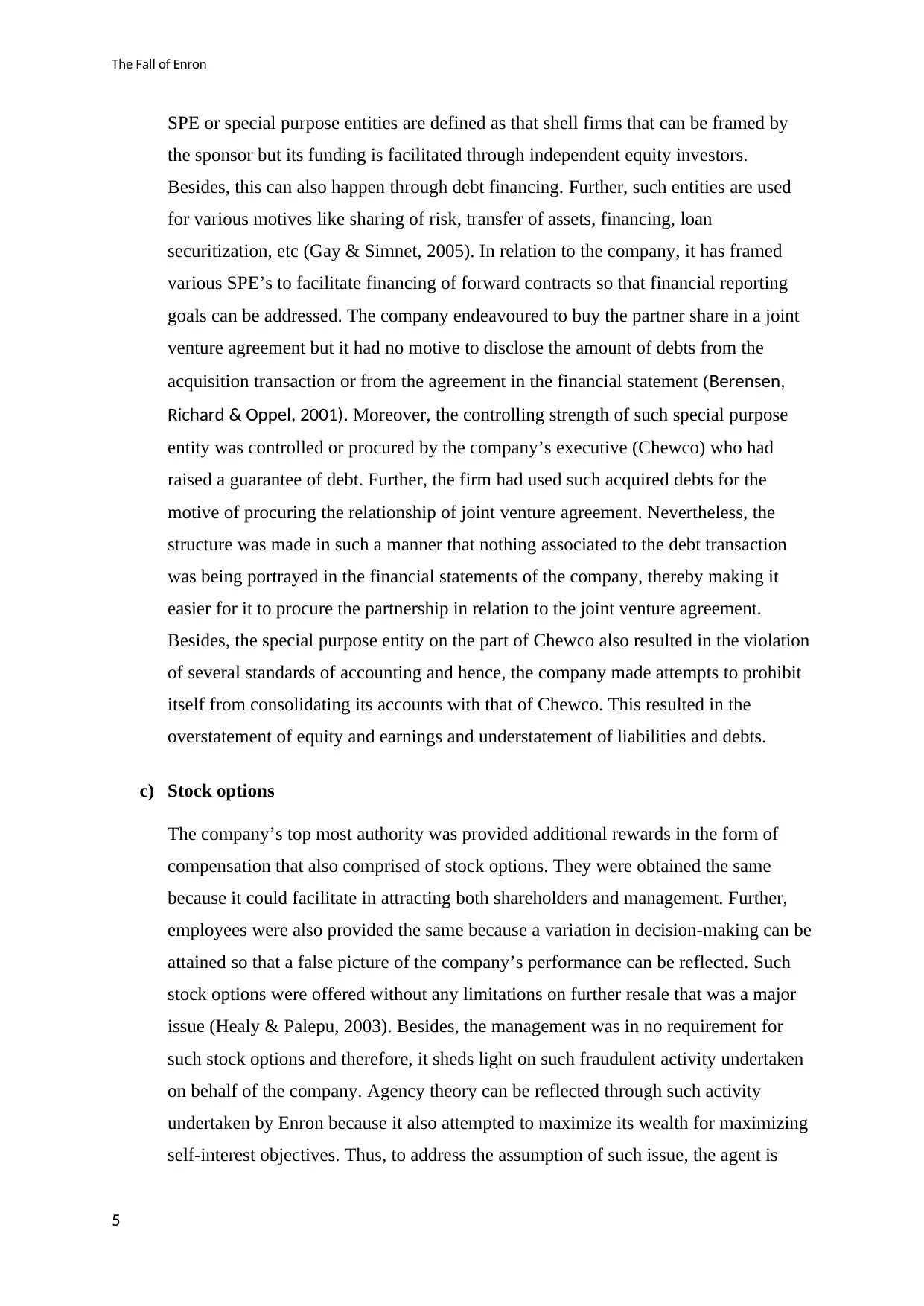
The Fall of Enron
SPE or special purpose entities are defined as that shell firms that can be framed by
the sponsor but its funding is facilitated through independent equity investors.
Besides, this can also happen through debt financing. Further, such entities are used
for various motives like sharing of risk, transfer of assets, financing, loan
securitization, etc (Gay & Simnet, 2005). In relation to the company, it has framed
various SPE’s to facilitate financing of forward contracts so that financial reporting
goals can be addressed. The company endeavoured to buy the partner share in a joint
venture agreement but it had no motive to disclose the amount of debts from the
acquisition transaction or from the agreement in the financial statement (Berensen,
Richard & Oppel, 2001). Moreover, the controlling strength of such special purpose
entity was controlled or procured by the company’s executive (Chewco) who had
raised a guarantee of debt. Further, the firm had used such acquired debts for the
motive of procuring the relationship of joint venture agreement. Nevertheless, the
structure was made in such a manner that nothing associated to the debt transaction
was being portrayed in the financial statements of the company, thereby making it
easier for it to procure the partnership in relation to the joint venture agreement.
Besides, the special purpose entity on the part of Chewco also resulted in the violation
of several standards of accounting and hence, the company made attempts to prohibit
itself from consolidating its accounts with that of Chewco. This resulted in the
overstatement of equity and earnings and understatement of liabilities and debts.
c) Stock options
The company’s top most authority was provided additional rewards in the form of
compensation that also comprised of stock options. They were obtained the same
because it could facilitate in attracting both shareholders and management. Further,
employees were also provided the same because a variation in decision-making can be
attained so that a false picture of the company’s performance can be reflected. Such
stock options were offered without any limitations on further resale that was a major
issue (Healy & Palepu, 2003). Besides, the management was in no requirement for
such stock options and therefore, it sheds light on such fraudulent activity undertaken
on behalf of the company. Agency theory can be reflected through such activity
undertaken by Enron because it also attempted to maximize its wealth for maximizing
self-interest objectives. Thus, to address the assumption of such issue, the agent is
5
SPE or special purpose entities are defined as that shell firms that can be framed by
the sponsor but its funding is facilitated through independent equity investors.
Besides, this can also happen through debt financing. Further, such entities are used
for various motives like sharing of risk, transfer of assets, financing, loan
securitization, etc (Gay & Simnet, 2005). In relation to the company, it has framed
various SPE’s to facilitate financing of forward contracts so that financial reporting
goals can be addressed. The company endeavoured to buy the partner share in a joint
venture agreement but it had no motive to disclose the amount of debts from the
acquisition transaction or from the agreement in the financial statement (Berensen,
Richard & Oppel, 2001). Moreover, the controlling strength of such special purpose
entity was controlled or procured by the company’s executive (Chewco) who had
raised a guarantee of debt. Further, the firm had used such acquired debts for the
motive of procuring the relationship of joint venture agreement. Nevertheless, the
structure was made in such a manner that nothing associated to the debt transaction
was being portrayed in the financial statements of the company, thereby making it
easier for it to procure the partnership in relation to the joint venture agreement.
Besides, the special purpose entity on the part of Chewco also resulted in the violation
of several standards of accounting and hence, the company made attempts to prohibit
itself from consolidating its accounts with that of Chewco. This resulted in the
overstatement of equity and earnings and understatement of liabilities and debts.
c) Stock options
The company’s top most authority was provided additional rewards in the form of
compensation that also comprised of stock options. They were obtained the same
because it could facilitate in attracting both shareholders and management. Further,
employees were also provided the same because a variation in decision-making can be
attained so that a false picture of the company’s performance can be reflected. Such
stock options were offered without any limitations on further resale that was a major
issue (Healy & Palepu, 2003). Besides, the management was in no requirement for
such stock options and therefore, it sheds light on such fraudulent activity undertaken
on behalf of the company. Agency theory can be reflected through such activity
undertaken by Enron because it also attempted to maximize its wealth for maximizing
self-interest objectives. Thus, to address the assumption of such issue, the agent is
5
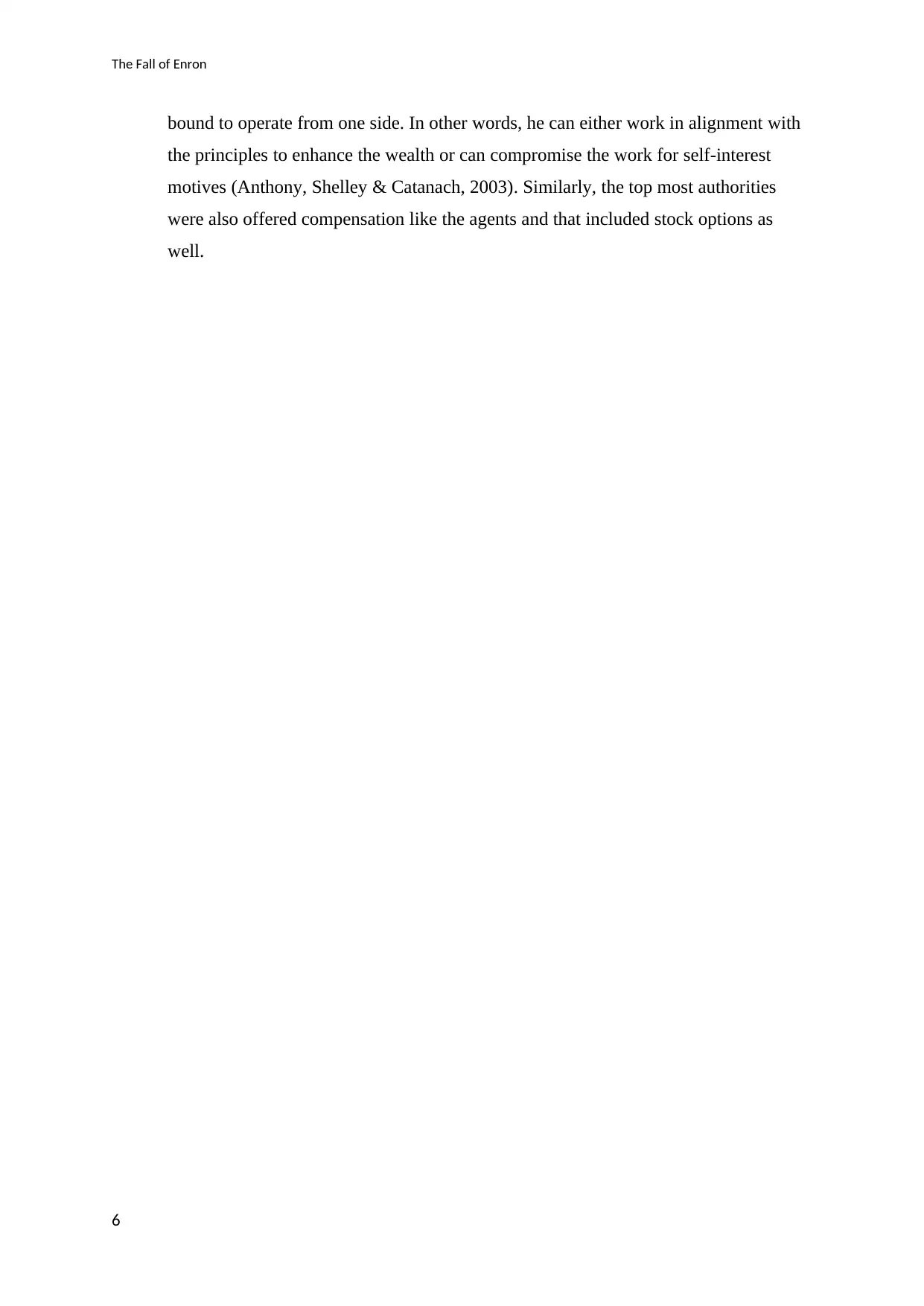
The Fall of Enron
bound to operate from one side. In other words, he can either work in alignment with
the principles to enhance the wealth or can compromise the work for self-interest
motives (Anthony, Shelley & Catanach, 2003). Similarly, the top most authorities
were also offered compensation like the agents and that included stock options as
well.
6
bound to operate from one side. In other words, he can either work in alignment with
the principles to enhance the wealth or can compromise the work for self-interest
motives (Anthony, Shelley & Catanach, 2003). Similarly, the top most authorities
were also offered compensation like the agents and that included stock options as
well.
6
⊘ This is a preview!⊘
Do you want full access?
Subscribe today to unlock all pages.

Trusted by 1+ million students worldwide
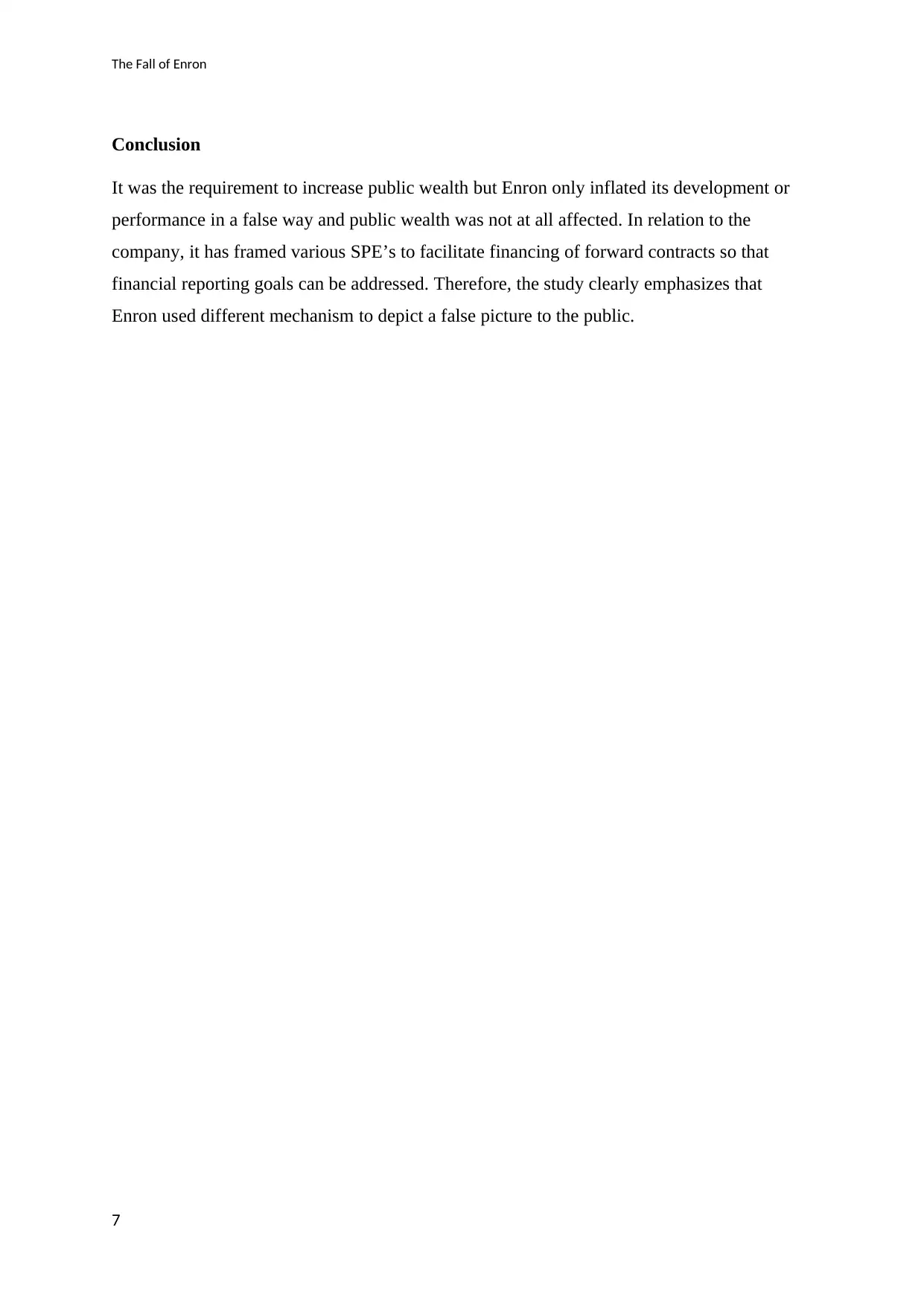
The Fall of Enron
Conclusion
It was the requirement to increase public wealth but Enron only inflated its development or
performance in a false way and public wealth was not at all affected. In relation to the
company, it has framed various SPE’s to facilitate financing of forward contracts so that
financial reporting goals can be addressed. Therefore, the study clearly emphasizes that
Enron used different mechanism to depict a false picture to the public.
7
Conclusion
It was the requirement to increase public wealth but Enron only inflated its development or
performance in a false way and public wealth was not at all affected. In relation to the
company, it has framed various SPE’s to facilitate financing of forward contracts so that
financial reporting goals can be addressed. Therefore, the study clearly emphasizes that
Enron used different mechanism to depict a false picture to the public.
7
Paraphrase This Document
Need a fresh take? Get an instant paraphrase of this document with our AI Paraphraser
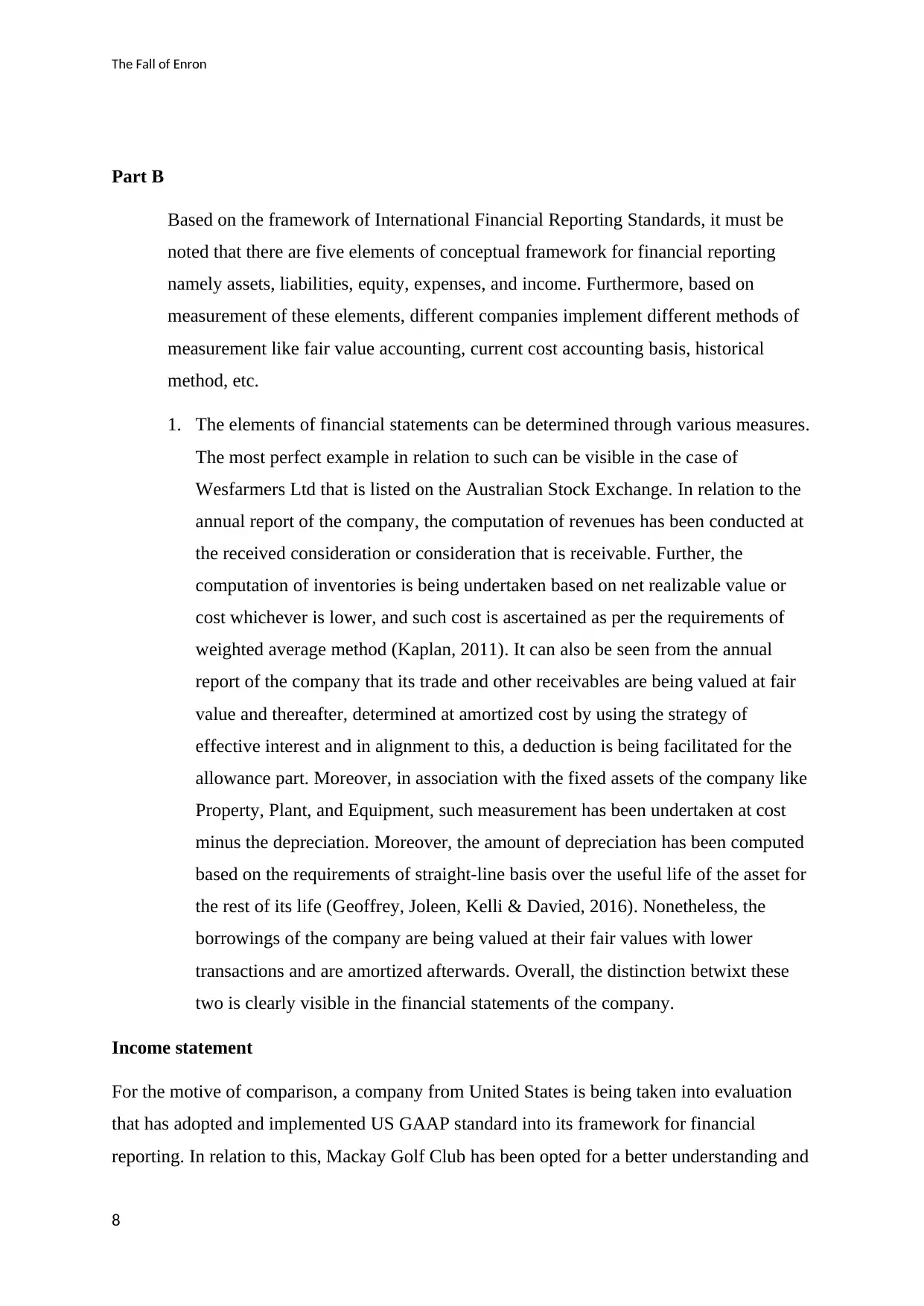
The Fall of Enron
Part B
Based on the framework of International Financial Reporting Standards, it must be
noted that there are five elements of conceptual framework for financial reporting
namely assets, liabilities, equity, expenses, and income. Furthermore, based on
measurement of these elements, different companies implement different methods of
measurement like fair value accounting, current cost accounting basis, historical
method, etc.
1. The elements of financial statements can be determined through various measures.
The most perfect example in relation to such can be visible in the case of
Wesfarmers Ltd that is listed on the Australian Stock Exchange. In relation to the
annual report of the company, the computation of revenues has been conducted at
the received consideration or consideration that is receivable. Further, the
computation of inventories is being undertaken based on net realizable value or
cost whichever is lower, and such cost is ascertained as per the requirements of
weighted average method (Kaplan, 2011). It can also be seen from the annual
report of the company that its trade and other receivables are being valued at fair
value and thereafter, determined at amortized cost by using the strategy of
effective interest and in alignment to this, a deduction is being facilitated for the
allowance part. Moreover, in association with the fixed assets of the company like
Property, Plant, and Equipment, such measurement has been undertaken at cost
minus the depreciation. Moreover, the amount of depreciation has been computed
based on the requirements of straight-line basis over the useful life of the asset for
the rest of its life (Geoffrey, Joleen, Kelli & Davied, 2016). Nonetheless, the
borrowings of the company are being valued at their fair values with lower
transactions and are amortized afterwards. Overall, the distinction betwixt these
two is clearly visible in the financial statements of the company.
Income statement
For the motive of comparison, a company from United States is being taken into evaluation
that has adopted and implemented US GAAP standard into its framework for financial
reporting. In relation to this, Mackay Golf Club has been opted for a better understanding and
8
Part B
Based on the framework of International Financial Reporting Standards, it must be
noted that there are five elements of conceptual framework for financial reporting
namely assets, liabilities, equity, expenses, and income. Furthermore, based on
measurement of these elements, different companies implement different methods of
measurement like fair value accounting, current cost accounting basis, historical
method, etc.
1. The elements of financial statements can be determined through various measures.
The most perfect example in relation to such can be visible in the case of
Wesfarmers Ltd that is listed on the Australian Stock Exchange. In relation to the
annual report of the company, the computation of revenues has been conducted at
the received consideration or consideration that is receivable. Further, the
computation of inventories is being undertaken based on net realizable value or
cost whichever is lower, and such cost is ascertained as per the requirements of
weighted average method (Kaplan, 2011). It can also be seen from the annual
report of the company that its trade and other receivables are being valued at fair
value and thereafter, determined at amortized cost by using the strategy of
effective interest and in alignment to this, a deduction is being facilitated for the
allowance part. Moreover, in association with the fixed assets of the company like
Property, Plant, and Equipment, such measurement has been undertaken at cost
minus the depreciation. Moreover, the amount of depreciation has been computed
based on the requirements of straight-line basis over the useful life of the asset for
the rest of its life (Geoffrey, Joleen, Kelli & Davied, 2016). Nonetheless, the
borrowings of the company are being valued at their fair values with lower
transactions and are amortized afterwards. Overall, the distinction betwixt these
two is clearly visible in the financial statements of the company.
Income statement
For the motive of comparison, a company from United States is being taken into evaluation
that has adopted and implemented US GAAP standard into its framework for financial
reporting. In relation to this, Mackay Golf Club has been opted for a better understanding and
8
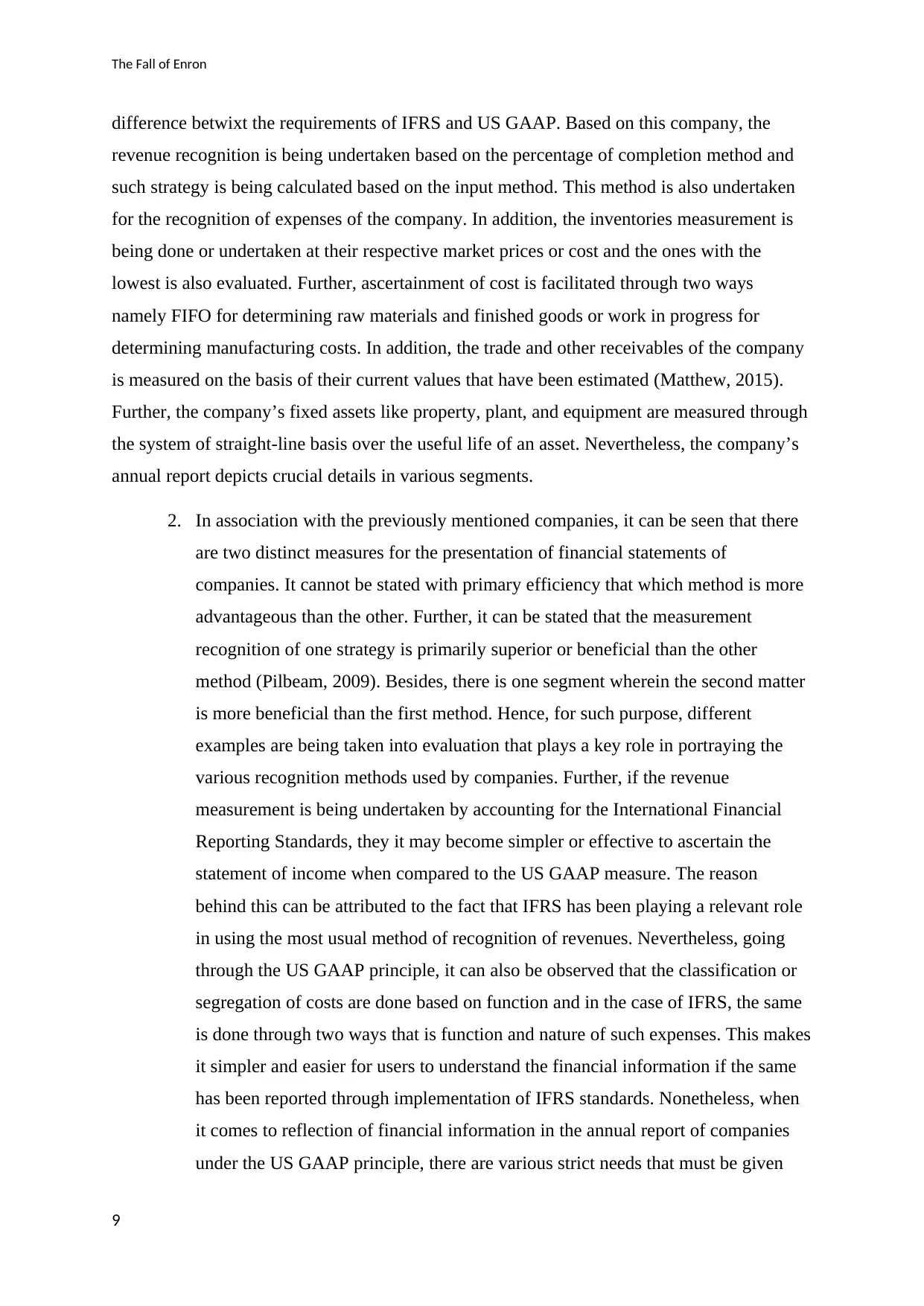
The Fall of Enron
difference betwixt the requirements of IFRS and US GAAP. Based on this company, the
revenue recognition is being undertaken based on the percentage of completion method and
such strategy is being calculated based on the input method. This method is also undertaken
for the recognition of expenses of the company. In addition, the inventories measurement is
being done or undertaken at their respective market prices or cost and the ones with the
lowest is also evaluated. Further, ascertainment of cost is facilitated through two ways
namely FIFO for determining raw materials and finished goods or work in progress for
determining manufacturing costs. In addition, the trade and other receivables of the company
is measured on the basis of their current values that have been estimated (Matthew, 2015).
Further, the company’s fixed assets like property, plant, and equipment are measured through
the system of straight-line basis over the useful life of an asset. Nevertheless, the company’s
annual report depicts crucial details in various segments.
2. In association with the previously mentioned companies, it can be seen that there
are two distinct measures for the presentation of financial statements of
companies. It cannot be stated with primary efficiency that which method is more
advantageous than the other. Further, it can be stated that the measurement
recognition of one strategy is primarily superior or beneficial than the other
method (Pilbeam, 2009). Besides, there is one segment wherein the second matter
is more beneficial than the first method. Hence, for such purpose, different
examples are being taken into evaluation that plays a key role in portraying the
various recognition methods used by companies. Further, if the revenue
measurement is being undertaken by accounting for the International Financial
Reporting Standards, they it may become simpler or effective to ascertain the
statement of income when compared to the US GAAP measure. The reason
behind this can be attributed to the fact that IFRS has been playing a relevant role
in using the most usual method of recognition of revenues. Nevertheless, going
through the US GAAP principle, it can also be observed that the classification or
segregation of costs are done based on function and in the case of IFRS, the same
is done through two ways that is function and nature of such expenses. This makes
it simpler and easier for users to understand the financial information if the same
has been reported through implementation of IFRS standards. Nonetheless, when
it comes to reflection of financial information in the annual report of companies
under the US GAAP principle, there are various strict needs that must be given
9
difference betwixt the requirements of IFRS and US GAAP. Based on this company, the
revenue recognition is being undertaken based on the percentage of completion method and
such strategy is being calculated based on the input method. This method is also undertaken
for the recognition of expenses of the company. In addition, the inventories measurement is
being done or undertaken at their respective market prices or cost and the ones with the
lowest is also evaluated. Further, ascertainment of cost is facilitated through two ways
namely FIFO for determining raw materials and finished goods or work in progress for
determining manufacturing costs. In addition, the trade and other receivables of the company
is measured on the basis of their current values that have been estimated (Matthew, 2015).
Further, the company’s fixed assets like property, plant, and equipment are measured through
the system of straight-line basis over the useful life of an asset. Nevertheless, the company’s
annual report depicts crucial details in various segments.
2. In association with the previously mentioned companies, it can be seen that there
are two distinct measures for the presentation of financial statements of
companies. It cannot be stated with primary efficiency that which method is more
advantageous than the other. Further, it can be stated that the measurement
recognition of one strategy is primarily superior or beneficial than the other
method (Pilbeam, 2009). Besides, there is one segment wherein the second matter
is more beneficial than the first method. Hence, for such purpose, different
examples are being taken into evaluation that plays a key role in portraying the
various recognition methods used by companies. Further, if the revenue
measurement is being undertaken by accounting for the International Financial
Reporting Standards, they it may become simpler or effective to ascertain the
statement of income when compared to the US GAAP measure. The reason
behind this can be attributed to the fact that IFRS has been playing a relevant role
in using the most usual method of recognition of revenues. Nevertheless, going
through the US GAAP principle, it can also be observed that the classification or
segregation of costs are done based on function and in the case of IFRS, the same
is done through two ways that is function and nature of such expenses. This makes
it simpler and easier for users to understand the financial information if the same
has been reported through implementation of IFRS standards. Nonetheless, when
it comes to reflection of financial information in the annual report of companies
under the US GAAP principle, there are various strict needs that must be given
9
⊘ This is a preview!⊘
Do you want full access?
Subscribe today to unlock all pages.

Trusted by 1+ million students worldwide
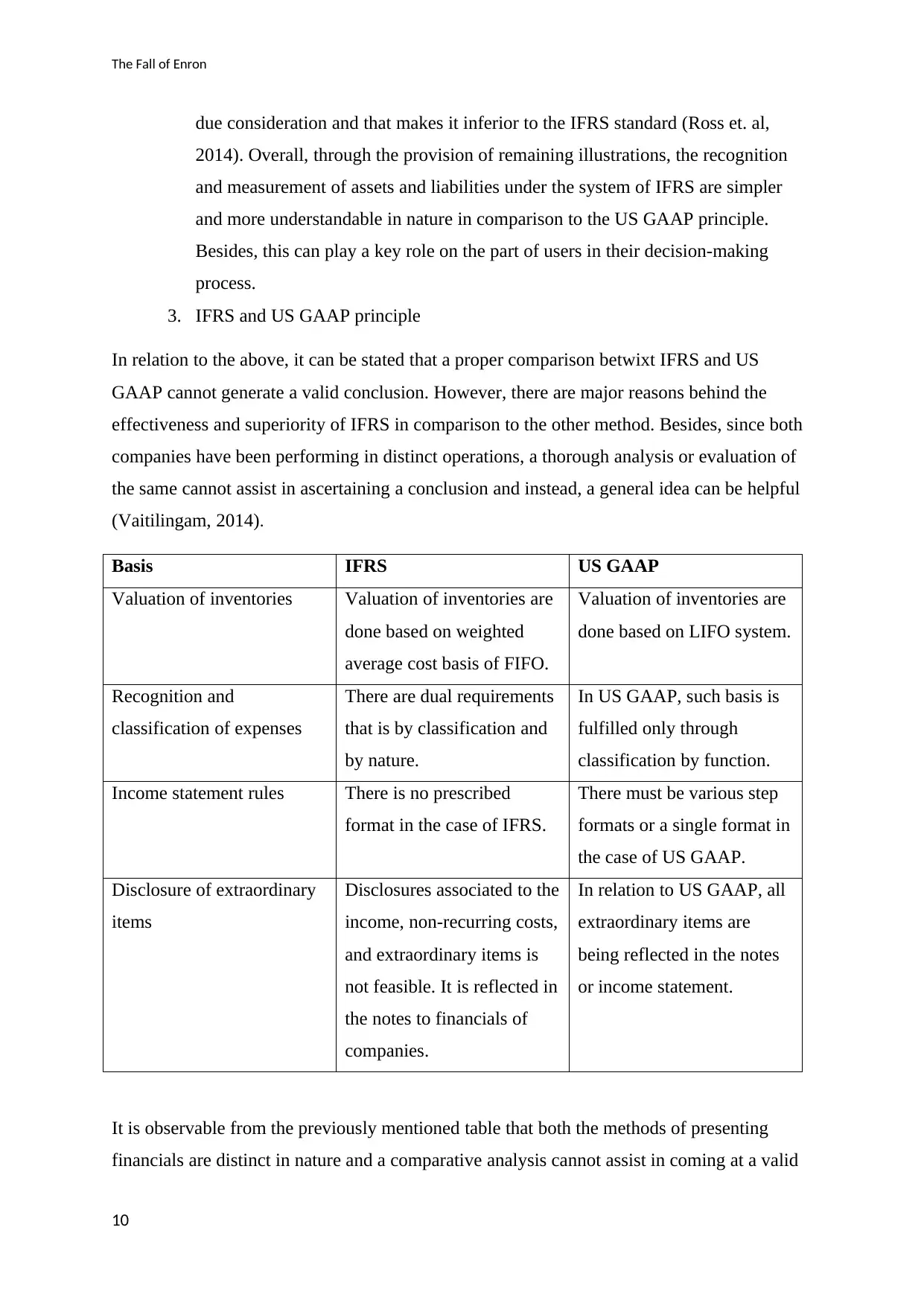
The Fall of Enron
due consideration and that makes it inferior to the IFRS standard (Ross et. al,
2014). Overall, through the provision of remaining illustrations, the recognition
and measurement of assets and liabilities under the system of IFRS are simpler
and more understandable in nature in comparison to the US GAAP principle.
Besides, this can play a key role on the part of users in their decision-making
process.
3. IFRS and US GAAP principle
In relation to the above, it can be stated that a proper comparison betwixt IFRS and US
GAAP cannot generate a valid conclusion. However, there are major reasons behind the
effectiveness and superiority of IFRS in comparison to the other method. Besides, since both
companies have been performing in distinct operations, a thorough analysis or evaluation of
the same cannot assist in ascertaining a conclusion and instead, a general idea can be helpful
(Vaitilingam, 2014).
Basis IFRS US GAAP
Valuation of inventories Valuation of inventories are
done based on weighted
average cost basis of FIFO.
Valuation of inventories are
done based on LIFO system.
Recognition and
classification of expenses
There are dual requirements
that is by classification and
by nature.
In US GAAP, such basis is
fulfilled only through
classification by function.
Income statement rules There is no prescribed
format in the case of IFRS.
There must be various step
formats or a single format in
the case of US GAAP.
Disclosure of extraordinary
items
Disclosures associated to the
income, non-recurring costs,
and extraordinary items is
not feasible. It is reflected in
the notes to financials of
companies.
In relation to US GAAP, all
extraordinary items are
being reflected in the notes
or income statement.
It is observable from the previously mentioned table that both the methods of presenting
financials are distinct in nature and a comparative analysis cannot assist in coming at a valid
10
due consideration and that makes it inferior to the IFRS standard (Ross et. al,
2014). Overall, through the provision of remaining illustrations, the recognition
and measurement of assets and liabilities under the system of IFRS are simpler
and more understandable in nature in comparison to the US GAAP principle.
Besides, this can play a key role on the part of users in their decision-making
process.
3. IFRS and US GAAP principle
In relation to the above, it can be stated that a proper comparison betwixt IFRS and US
GAAP cannot generate a valid conclusion. However, there are major reasons behind the
effectiveness and superiority of IFRS in comparison to the other method. Besides, since both
companies have been performing in distinct operations, a thorough analysis or evaluation of
the same cannot assist in ascertaining a conclusion and instead, a general idea can be helpful
(Vaitilingam, 2014).
Basis IFRS US GAAP
Valuation of inventories Valuation of inventories are
done based on weighted
average cost basis of FIFO.
Valuation of inventories are
done based on LIFO system.
Recognition and
classification of expenses
There are dual requirements
that is by classification and
by nature.
In US GAAP, such basis is
fulfilled only through
classification by function.
Income statement rules There is no prescribed
format in the case of IFRS.
There must be various step
formats or a single format in
the case of US GAAP.
Disclosure of extraordinary
items
Disclosures associated to the
income, non-recurring costs,
and extraordinary items is
not feasible. It is reflected in
the notes to financials of
companies.
In relation to US GAAP, all
extraordinary items are
being reflected in the notes
or income statement.
It is observable from the previously mentioned table that both the methods of presenting
financials are distinct in nature and a comparative analysis cannot assist in coming at a valid
10
Paraphrase This Document
Need a fresh take? Get an instant paraphrase of this document with our AI Paraphraser
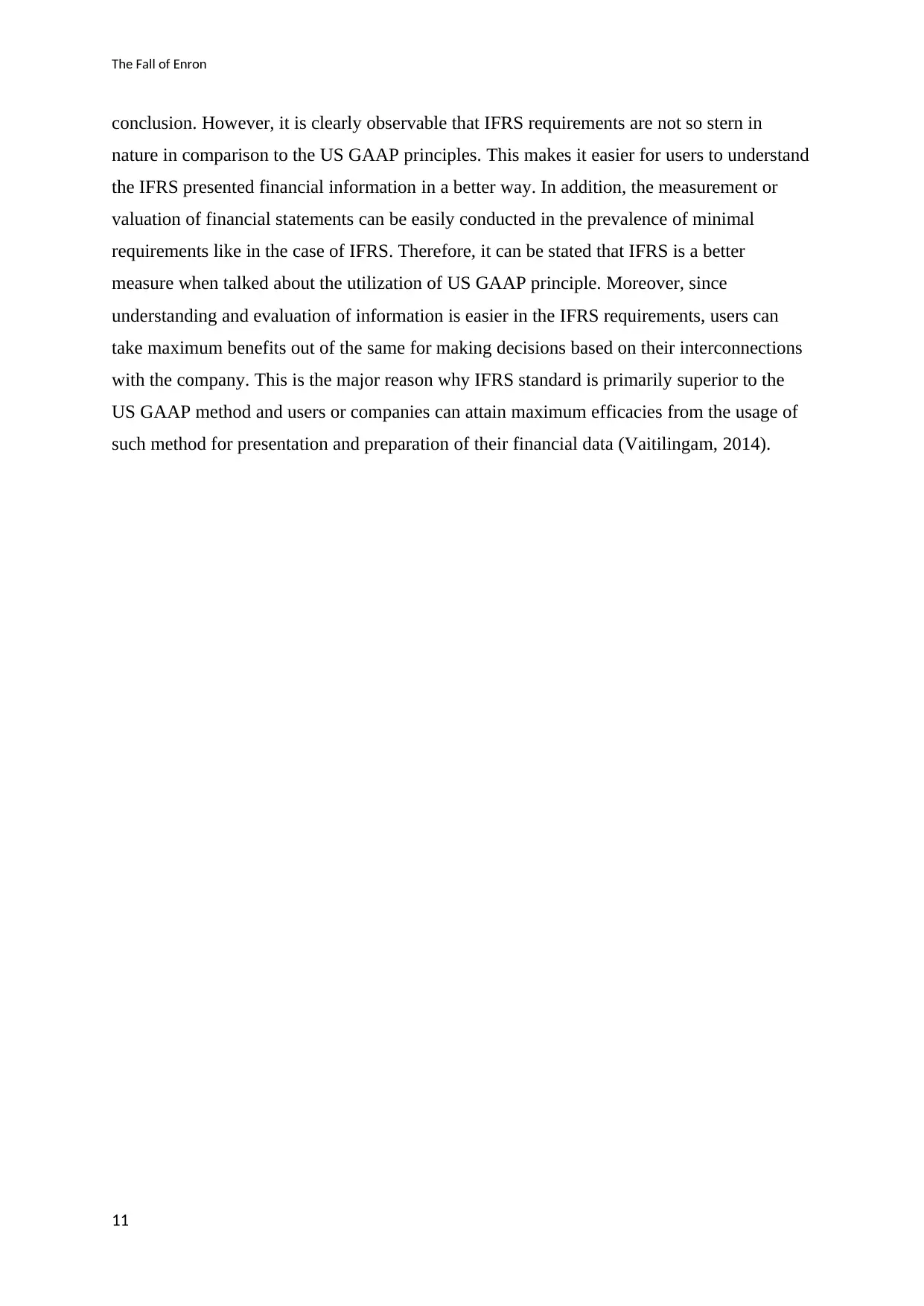
The Fall of Enron
conclusion. However, it is clearly observable that IFRS requirements are not so stern in
nature in comparison to the US GAAP principles. This makes it easier for users to understand
the IFRS presented financial information in a better way. In addition, the measurement or
valuation of financial statements can be easily conducted in the prevalence of minimal
requirements like in the case of IFRS. Therefore, it can be stated that IFRS is a better
measure when talked about the utilization of US GAAP principle. Moreover, since
understanding and evaluation of information is easier in the IFRS requirements, users can
take maximum benefits out of the same for making decisions based on their interconnections
with the company. This is the major reason why IFRS standard is primarily superior to the
US GAAP method and users or companies can attain maximum efficacies from the usage of
such method for presentation and preparation of their financial data (Vaitilingam, 2014).
11
conclusion. However, it is clearly observable that IFRS requirements are not so stern in
nature in comparison to the US GAAP principles. This makes it easier for users to understand
the IFRS presented financial information in a better way. In addition, the measurement or
valuation of financial statements can be easily conducted in the prevalence of minimal
requirements like in the case of IFRS. Therefore, it can be stated that IFRS is a better
measure when talked about the utilization of US GAAP principle. Moreover, since
understanding and evaluation of information is easier in the IFRS requirements, users can
take maximum benefits out of the same for making decisions based on their interconnections
with the company. This is the major reason why IFRS standard is primarily superior to the
US GAAP method and users or companies can attain maximum efficacies from the usage of
such method for presentation and preparation of their financial data (Vaitilingam, 2014).
11
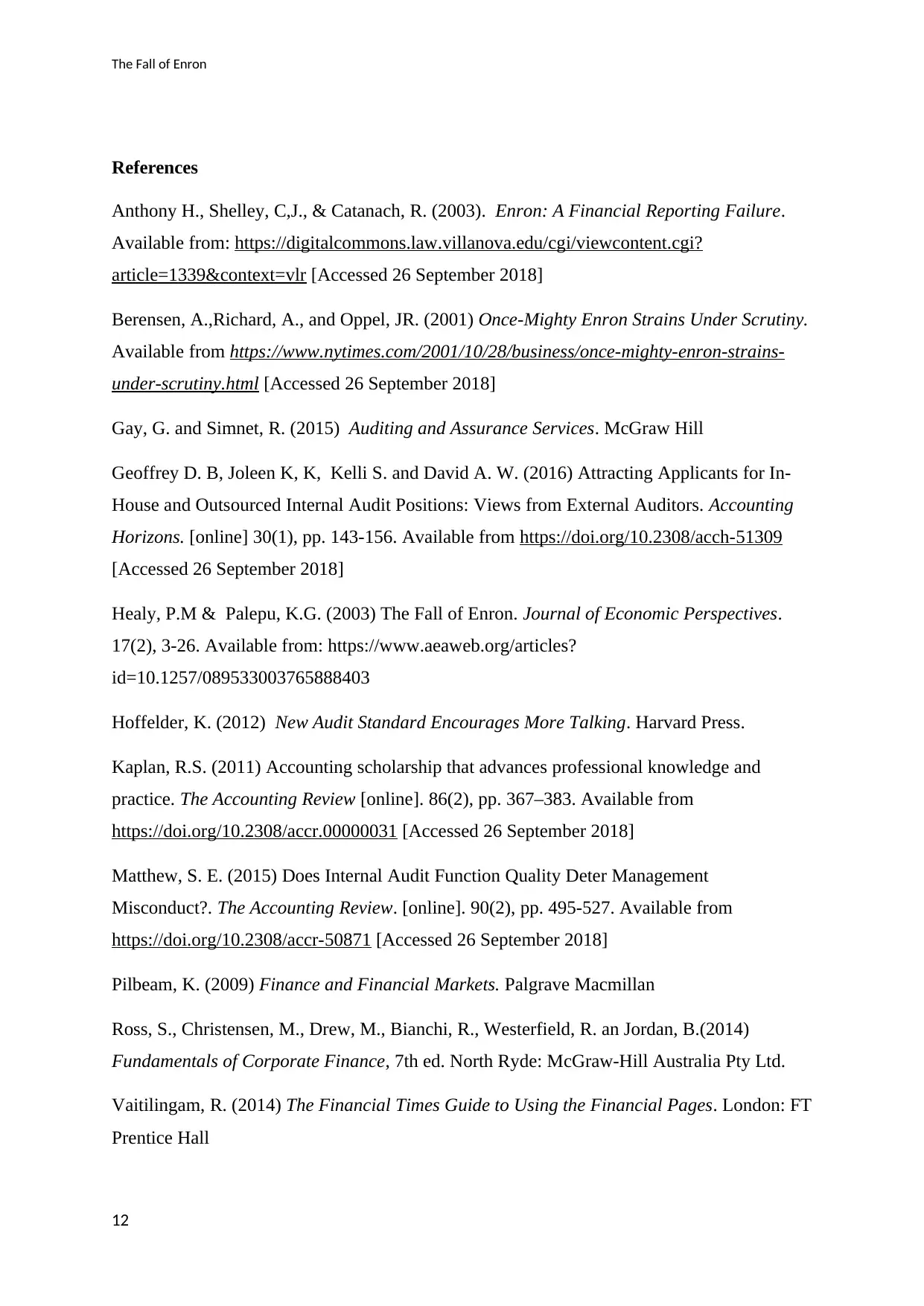
The Fall of Enron
References
Anthony H., Shelley, C,J., & Catanach, R. (2003). Enron: A Financial Reporting Failure.
Available from: https://digitalcommons.law.villanova.edu/cgi/viewcontent.cgi?
article=1339&context=vlr [Accessed 26 September 2018]
Berensen, A.,Richard, A., and Oppel, JR. (2001) Once-Mighty Enron Strains Under Scrutiny.
Available from https://www.nytimes.com/2001/10/28/business/once-mighty-enron-strains-
under-scrutiny.html [Accessed 26 September 2018]
Gay, G. and Simnet, R. (2015) Auditing and Assurance Services. McGraw Hill
Geoffrey D. B, Joleen K, K, Kelli S. and David A. W. (2016) Attracting Applicants for In-
House and Outsourced Internal Audit Positions: Views from External Auditors. Accounting
Horizons. [online] 30(1), pp. 143-156. Available from https://doi.org/10.2308/acch-51309
[Accessed 26 September 2018]
Healy, P.M & Palepu, K.G. (2003) The Fall of Enron. Journal of Economic Perspectives.
17(2), 3-26. Available from: https://www.aeaweb.org/articles?
id=10.1257/089533003765888403
Hoffelder, K. (2012) New Audit Standard Encourages More Talking. Harvard Press.
Kaplan, R.S. (2011) Accounting scholarship that advances professional knowledge and
practice. The Accounting Review [online]. 86(2), pp. 367–383. Available from
https://doi.org/10.2308/accr.00000031 [Accessed 26 September 2018]
Matthew, S. E. (2015) Does Internal Audit Function Quality Deter Management
Misconduct?. The Accounting Review. [online]. 90(2), pp. 495-527. Available from
https://doi.org/10.2308/accr-50871 [Accessed 26 September 2018]
Pilbeam, K. (2009) Finance and Financial Markets. Palgrave Macmillan
Ross, S., Christensen, M., Drew, M., Bianchi, R., Westerfield, R. an Jordan, B.(2014)
Fundamentals of Corporate Finance, 7th ed. North Ryde: McGraw-Hill Australia Pty Ltd.
Vaitilingam, R. (2014) The Financial Times Guide to Using the Financial Pages. London: FT
Prentice Hall
12
References
Anthony H., Shelley, C,J., & Catanach, R. (2003). Enron: A Financial Reporting Failure.
Available from: https://digitalcommons.law.villanova.edu/cgi/viewcontent.cgi?
article=1339&context=vlr [Accessed 26 September 2018]
Berensen, A.,Richard, A., and Oppel, JR. (2001) Once-Mighty Enron Strains Under Scrutiny.
Available from https://www.nytimes.com/2001/10/28/business/once-mighty-enron-strains-
under-scrutiny.html [Accessed 26 September 2018]
Gay, G. and Simnet, R. (2015) Auditing and Assurance Services. McGraw Hill
Geoffrey D. B, Joleen K, K, Kelli S. and David A. W. (2016) Attracting Applicants for In-
House and Outsourced Internal Audit Positions: Views from External Auditors. Accounting
Horizons. [online] 30(1), pp. 143-156. Available from https://doi.org/10.2308/acch-51309
[Accessed 26 September 2018]
Healy, P.M & Palepu, K.G. (2003) The Fall of Enron. Journal of Economic Perspectives.
17(2), 3-26. Available from: https://www.aeaweb.org/articles?
id=10.1257/089533003765888403
Hoffelder, K. (2012) New Audit Standard Encourages More Talking. Harvard Press.
Kaplan, R.S. (2011) Accounting scholarship that advances professional knowledge and
practice. The Accounting Review [online]. 86(2), pp. 367–383. Available from
https://doi.org/10.2308/accr.00000031 [Accessed 26 September 2018]
Matthew, S. E. (2015) Does Internal Audit Function Quality Deter Management
Misconduct?. The Accounting Review. [online]. 90(2), pp. 495-527. Available from
https://doi.org/10.2308/accr-50871 [Accessed 26 September 2018]
Pilbeam, K. (2009) Finance and Financial Markets. Palgrave Macmillan
Ross, S., Christensen, M., Drew, M., Bianchi, R., Westerfield, R. an Jordan, B.(2014)
Fundamentals of Corporate Finance, 7th ed. North Ryde: McGraw-Hill Australia Pty Ltd.
Vaitilingam, R. (2014) The Financial Times Guide to Using the Financial Pages. London: FT
Prentice Hall
12
⊘ This is a preview!⊘
Do you want full access?
Subscribe today to unlock all pages.

Trusted by 1+ million students worldwide
1 out of 12
Related Documents
Your All-in-One AI-Powered Toolkit for Academic Success.
+13062052269
info@desklib.com
Available 24*7 on WhatsApp / Email
![[object Object]](/_next/static/media/star-bottom.7253800d.svg)
Unlock your academic potential
Copyright © 2020–2025 A2Z Services. All Rights Reserved. Developed and managed by ZUCOL.





